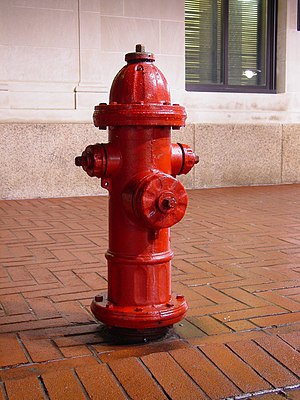Fire hydrant
Jump to navigation
Jump to search
With rare exceptions Fire departments rely on underground pipes when fighting fires, with regularly spaced fire hydrants emerging from the ground to allow fire engines to attach hoses, for the actual fire-fighting.[1][2][3][4]
References
- ↑ All about fire hydrants, Canadian Fire Fighters Museum. Retrieved on 2023-12-08. “Tradition has it that about 1801, Frederick Graff, chief engineer of the Philadelphia Water Works, patented a post-style fire hydrant resembling what we use today. Other sources say that first fire hydrant was invented by George Smith, a firefighter, about 1817, when he realized that Manhattan, where he lived, was running out of water for citizens to use — not just for fighting fires, but for every day uses as well.”
- ↑ 6 Fun Facts About Fire Hydrants, Cityworks, 2021-05-10. Retrieved on 2023-12-08. “The invention of the fire hydrant is unofficially credited to Frederick Graff, chief engineer of Philadelphia Water Works, in 1801. Ironically, the official fire hydrant patent is rumored to have been destroyed in a fire.”
- ↑ A Brief History of the Hydrant, Firehydrant.org. Retrieved on 2023-12-08. “Firefighting existed before the hydrant and the idea of getting the wet stuff onto the red stuff is very old. The inventor of the first device that we'd recognize today as a fire hydrant can't be told, because the hydrant was developed over a period of many years by many people.”
- ↑ The History of the Fire Hydrant, Inspect Point. Retrieved on 2023-12-08. “Do you know who invented the fire hydrant? Neither do we. In fact, no one truly knows who invented the first fire hydrant system. However, we do know that it was invented in Philadelphia, Pennsylvania in the early 1800s.”

















